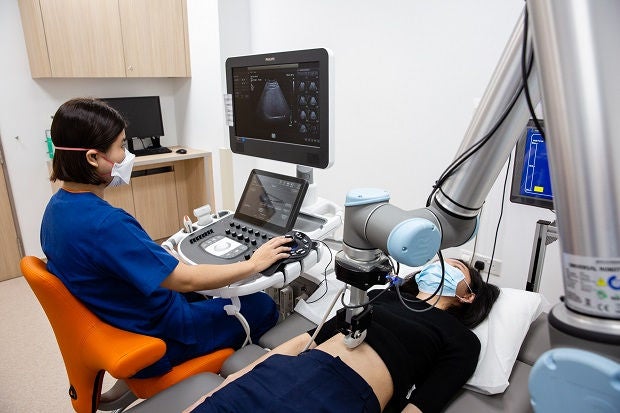
A robotic arm has been developed to lessen
the strain on radiographers.
Radiographers play an important role in performing medical imaging to help diagnose patients with injuries or illnesses. However, the repetitive actions needed to scan patients manually with an ultrasound probe often lead to chronic joint injuries in the radiographer’s shoulder, neck and wrist, as well as back pain.
Take Ms Kho Ying Ying (below), Senior Principal Radiographer, Singapore General Hospital (SGH), for example. Ms Kho uses a range of ultrasound probes and different manoeuvres to obtain images of diagnostic quality to aid in patients’ diagnosis. Some ultrasound examinations can be challenging — for instance, portable scans, transvaginal scans and scanning patients with high body mass index (BMI) — where she has to assume awkward postures during the scan, stretching her arm to ensure that patients and the equipment are in the right position, thereby putting herself at risk of Work-Related Musculoskeletal Disorders (WRMSDs).

The main causes of WRMSDs include awkward postures or improper positioning during scanning, repetitive scanning motions using force, and long durations of gripping.
“After performing a series of technically challenging cases, my arm is stretched out, and I can feel the strain on my shoulder and arm,” said Ms Kho.
To minimise such injuries, a team of physiotherapists and radiographers from SGH and Sengkang General Hospital (SKH) have utilised a robotic arm, which acts as the radiographer’s ‘arm’ to hold and move the ultrasound probe when scanning patients.
Known as ROBUST (Robotic Assisted Ultrasonography System), this technology was developed with the help of robotic software engineers.
“ROBUST can lessen the strain on radiographers who previously had to hold the probe and stretch over the patients when doing the scans,” said Professor Celia Tan (below), Senior Director (Special Projects), SingHealth, and the Principal Investigator of the project team.

“A sonographer or radiographer performing ultrasound scans would have to see about 15 patients a day. The repetitive movements throughout the day can cause muscle injuries or WRMSDs. With ROBUST, the scan can now be done using a robotic arm holding the ultrasound probe instead,” said Prof Tan.
For ultrasound radiographers like Ms Kho, her work can be less strenuous with ROBUST, as she manipulates the mouse to move the robotic arm to perform ultrasound scans for the liver, gall bladder, kidneys, spleen and pancreas over the patient’s abdominal area.
By leveraging robotic technology, the team believes that they have found a modern innovative solution to the age-old problem of WRMSDs.
“The robot arm is already available commercially. It is used in other manufacturing industries for physically laborious work, such as packing and car assembly. However, this is the first time it is used in a healthcare setting,” Prof Tan said.
Reducing risks
A physiotherapist by training, Prof Tan said that the hospitals have seen an increase in the number of ultrasound scans performed in the last few years, which puts ultrasound radiographers at a higher risk of over-exertion and injury.
In 2019, there were an average of 695 and 194 ultrasound scans performed in SGH and SKH respectively per week. This has increased by 53 and 32 scans respectively per week in 2020.
Prof Tan said that they received many positive feedback from radiographers and patients following a recent trial on the use of ROBUST at SGH and SKH.
“With ROBUST, the efficiency of capturing diagnostic quality images is not compromised in comparison to conventional scans. The radiographers also felt it was less strenuous on them to use the mouse, compared to physically stretching over the patient to hold the probe,” she added.
Patients who had participated in the trial felt that the pressure exerted by the robotic arm was acceptable and they did not feel any discomfort.
Although some shared that the use of the robotic arm seemed intimidating at first, they were reassured as the radiographer was seated next to them throughout the scanning process, ensuring that the procedure is executed safely.
“Some patients still prefer the human touch when undergoing a scan, but most of them are accepting of the robotic arm,” said Ms Kho. “Those who have undergone the scan with the robotic arm are willing to repeat the experience in future scans.”
In addition, ROBUST can also reduce the risk of any infection exposure by ensuring safe distance between the radiographer and the patient.
The future of ROBUST
The ROBUST study was awarded more than $1.3 million in 2017 from the MOH Ageless Workplaces Innovation Grant under the National Innovation Challenge on Active and Confident Ageing.
The project team is currently in discussions with a local robotic solutions company to commercialise the system, and plans to roll it out in other SingHealth institutions and hospitals from 2023 onwards.
More projects are being explored to programme the robot arm to scan autonomously in the future. Such devices can lower the risk of work injuries or fatigue, and even allow senior staff to continue in this area of work.
Get the latest updates about Singapore Health in your mailbox! Click here to subscribe.













 Get it on Google Play
Get it on Google Play